A little over nine years ago Games Workshop closed its books on Warhammer Fantasy Battle for what was believed to be the last time. The End Times Campaign had run its course, Archaon had become the first successful Everchosen (at Chaos’s 13th attempt) and the world was ending. Square bases were soon to become a thing of the past and Age of Sigmar would be launched. The Old World was gone and in it’s place were the Eight Realms.
Since then Warhammer Fantasy has lived on through the community which still loved to play the game. The sixth and eighth editions of the game are still reasonably popular while The 9th Age and the Warhammer Army Projects have both tried to improve on the last Games Workshop publication and provide support for the system in hibernation. Meanwhile the world that was has lived on for a lot of people in the form of the Total War: Warhammer series. The mass strategy game showcasing the Warhammer World on a massive scale has proved popular, with Steam recording it’s peak players at over 165 thousand concurrent players.
Fast forward to today and we’re on the cusp of the release of Games Workshops newest game, Warhammer: The Old World. They are once again asking us to return to the Old World but not to the time we knew from previous editions, instead we’ve moving back to the time leading up to the Siege of Praag and the invasion of the 12th Everchosen of Chaos. As a result, a few things will be different from what people remember from versions of Warhammer Fantasy, chances are some of your favourite heroes or villains haven’t even been born yet. That’s not to say there won’t be some familiar faces around but get ready to meet a whole different generation of characters leading their armies into battle.
Thanks to Games Workshop for providing us with a review copy of the Old World.
Warhammer: The Old world isn’t Warhammer ninth edition. This is it’s own game following in the footsteps of different editions of Warhammer Fantasy Battle with different influences from over 30 years of different games. It’s still Warhammer Fantasy, you don’t have to worry about it not feeling like the game you either still or used to play, but it’s been reimagined. There are many things you’ll remember or think “that’s familiar” with when you read it but when playing you need to try and remember to read the rules and not just do what you’ve done in Warhammer Fantasy Battle in years gone by.
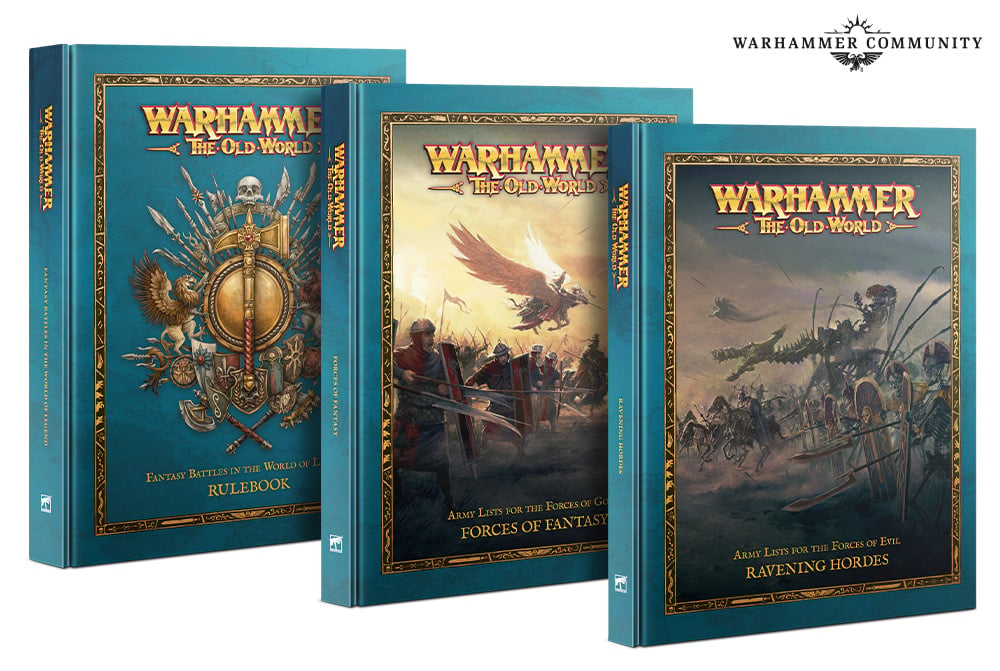
The best place to start with this seems to be the book itself. When I first saw the rulebook for this I was a little taken back with just how pretty it is. With Artwork spread throughout ranging from bits of artwork I can remember from older publications to newly commissioned pieces where they’ve somehow raised the standard the book itself is fantastic bit of kit and will certainly have fans of a certain age fawning over every page turn. The other thing to say is that it’s not a small book. With the book itself being over 350 pages long and well over 200 of those pages being dedicated to the rules I’d highly recommend setting aside some serious time to reading the book and learning where certain things are within it, Games Workshop have very much been implying this wouldn’t be a starter wargame in their communications with the community on Warhammer Community and this book does reinforce that.
Table of Contents
Introduction
Anyway, enough of me talking about this new Big Blue rulebook and lets get into the meat of it shall we? What game are we playing when we pick it up and how is it compared to what we’ve known before? As mentioned earlier it’s not Warhammer Fantasy ninth edition but what it does do is take aspects of the game from different editions of Warhammer Fantasy over the years and pick the best aspects of each, then add in some new ideas and some core principles which I feel is going to massively widen its appeal. We’re not just going to see veterans playing it for old time sakes, we’re going to see players engaging with the game ane being excited to to see what Games Workshop will do next with aspects of it as hopefully evolves over the coming years.
Unit Profiles
The rules begin with unit profiles. For those who played Warhammer Fantasy or Horus Heresy these won’t come as a shock to you, but for those who haven’t seen an older style profile there are a few key differences. Ballistic Skill (BS) is an example here; rather than a fixed value you need to roll to hit, you have a stat representing how skilled the model is at shooting, and you have to compare that to a table to determine what you need to roll.
The other key thing here is that they explain how characteristic tests work where you have to roll equal or under a specific characteristic stat in order to avoid damage from certain abilities. It also goes through the other information included in character profiles, so lets have a quick look at that through the example provided by the Warhammer Community Team in the Grail Knights.

Here we see that each unit has a name and the points cost per model. In addition you’ve got the stat line showing how good they are at fighting (WS), shooting a bow (BS), how strong or tough they are (S & T) along with how much damage they can take before succumbing to their wounds (W) and how quick they are on their feet with both a movement (M) and initiative (I) characteristics (which feels much more important in the new game). Finally, we have how many attacks the character gets in combat (A) and a Ld stat summing up how likely they are to stick around when things get a little rough, either in combat or when staring down a Dragon ten times their size.
A running feature of The Old World is how things have been categorised and keyworded and the unit profiles are no different. Here we see information on what Troop Type applies to the unit, which interacts with other rules and may determine the number of models required to be in a rank or how it moves through terrain. We have the all important base size information which denotes what size base the model should be played on and the unit size, in this example the Bretonnian Grail Knights are 3+ signalling that they have a minimum unit size but no maximum. Other units may have a cap on that and that will be show with an end number, such as the 1-9 on Dragon Ogres.
We have the equipment which a model is equipped with and each of those have rules found either in the rulebook for more common items such as Heavy Armour or a Lance or can be found in the two accompanying books (Ravening Hordes or Force of Fantasy) where it’s a unit specific item, such as the Sword of Hoeth used by High Elf Swordmasters. Following from that we have options for the unit and this goes into detail such as weapon options, command options for the units (more on those later) and special rules they might be able to take. All of these are found directly with the unit profiles in the books and help avoid a little big of flicking back and forth when constructing muster lists for your forces.
Finally we have the Special Rules at the bottom, these are usually a selection from a mix of 75 Universal Special rules which apply to a lot of different units over the game and some which might apply to certain races and some which apply to specific units. This might seem like a fairly daunting list but I do feel that the keyword system is the best way to approach this. For example on the Grail Knights above they have nine Special Rules of which four are in the main book and could apply to any unit in the game. We then have three Special Rules which apply to Bretonnian’s specifically and another two which are all but Unique to the Grail Knights. This system does apply to a lot of units in the game but most of the mainstays of your army won’t be getting more than a small handful (Grail Knights are pretty special), most of which cover just how they operate on the tabletop. As with any keyword system it can seem daunting but once you know what “Close Order” means for example it’s very easy to apply it to any different unit with that rule.
Forming Units
Forming units is key to Warhammer: The Old World and next up we have rules on how to do that. This includes explaining how model facing works and an outline of the five broad unit types in the game, plus the subtypes within those. For example Infantry is broken down into Regular, Heavy and Monstrous and this changes certain aspects of how they work in the game. For example, while any one of those three infantry types can claim a +2 rank bonus in combat (more on that later) each has different Unit Strengths (which interact with different rules) and requires a different number of models per rank to claim that bonus. I’m a big fan of this last bit in particular with it representing that the most lowly peasants might need more numbers to boost their strength in combat while fearsome Chaos Warriors need fewer and mighty monstrous infantry, towering over normal humans, need even fewer to feel great in combat.
That rounds out the core principles, so we’re now ready to dive into sections detailing how different parts of the game work. Let’s get the big one out of the way first for anyone who’s played Warhammer Fantasy in the past or spent hours in front of a monitor with Total War: Magic.
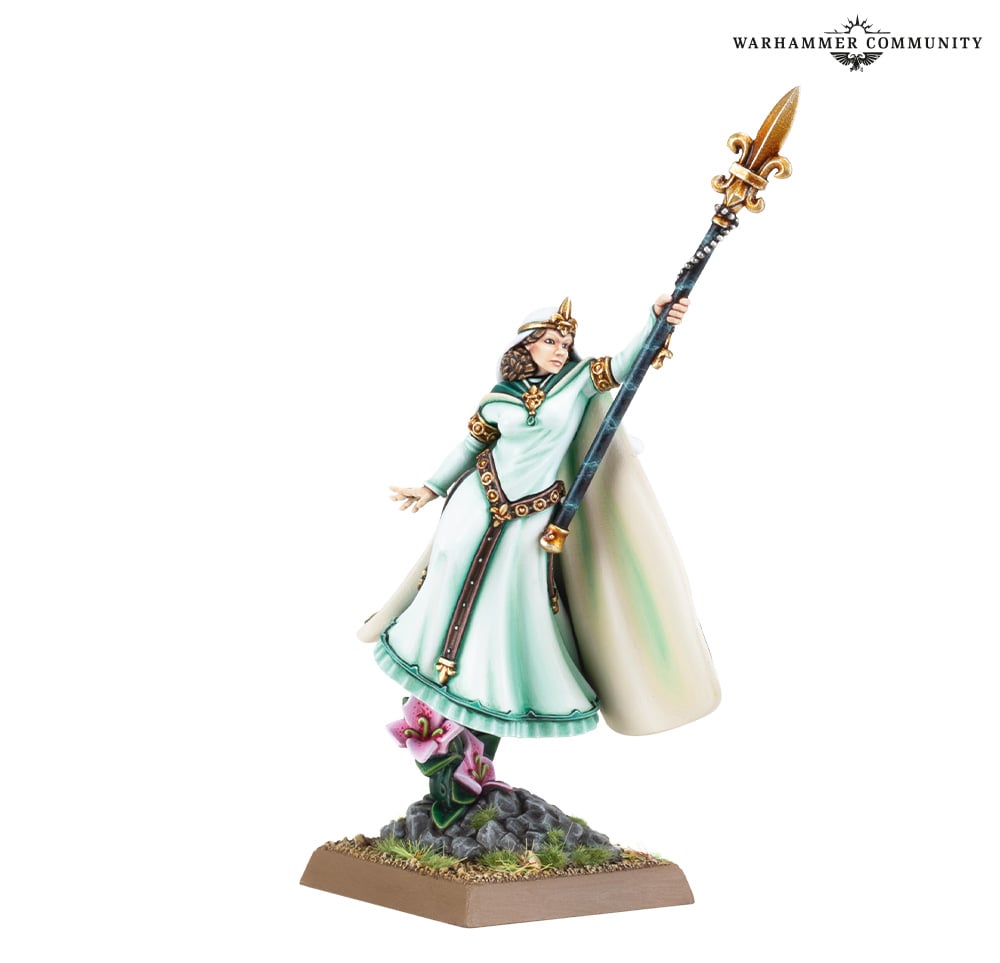
Magic
This is potentially the biggest shift from any version of Warhammer Fantasy and, in my opinion, is one of the elements which makes TOW a new game in it’s own right. The Warhammer World is filled with wizards, witches and sorcerers who can augment your own units, act as a detriment to enemy units or just blast entire regiments from the table with an array of spells, and while that last one doesn’t happen often, it can certainly tilt a battle in your advantage when it does!
Wizards are ranked by level (Lv) with Lv1 wizards being of humble ability while those of Lv4 being legends and able to dominate a battlefield. They know spells generated (roll for) from either the 8 main Lores of Magic or their own army specific Magic Lore. Each spell has a value representing how hard it is to cast, and is used at different points depending on the spells categorisation.
- Enchantment spells are cast in the Strategy Phase and usually buff your units in some way.
- Hex spells are also cast in the Strategy Phase and aim to take your opponents units down a peg.
- Conveyance Spells are cast in the movement phase and include spells which magically move your units around the battlefield.
- Magic Missiles are cast in the Shooting Phase and here’s where you find your typical fireball spells.
- Magical Vortex spells are also cast in the Shooting Phase and represent wizards summoning entities or objects which can stay on the battlefield changing it’s layout or powerful magical energies which can run rampant across both enemy and friendly units on the battlefield.
- Assailment spells are cast in the combat phase and represent your Wizard using their powers up close and personal with the enemy.
The way you cast these spells is fairly simple. During the appropriate, phase roll 2D6 and add your Wizard Level to the roll. If you equal or beat the value of the spell it’s a success and unless the opponent can stop you (Dispel) it takes effect. Dispelling is similar, if you have a wizard in range of the opposing wizard (18” for Lv1/2, 24” for Lv3/4) then again roll 2D6 and add your wizarding level. Beat your opponents roll and you’ll Dispel their attempt to cast the spell. At it’s base level it’s that simple but when you’ve played a few games and are trying to make the most of your magic you’ll see that it’s anything but.
A quick skim of the rules might lead to thinking that you’re just rolling dice and hoping, but that really isn’t the case. You’ve got to position your wizards where you can make the most of their spells (usually 12-18” range) while trying to stay outside of your opponents wizard who’s trying to dispel. Your opponent might move a Wizard forward in their turn to be 22” away ready to dispel your Enchantment or Hex spells but you might be able to move back to be more than 24” away allowing you to cast your Magic Missiles or Vortex spells on their units. But do you actually want to do that, if it means you’re now too far away from their wizard when they try to cast their Enchantment or Hex spells in their next turn? It leads to a game of chicken and positioning which is something some versions of Warhammer Fantasy lacked in the past where the only thing which mattered was being within range of the unit you wanted to blast.
Casting magic doesn’t come without risks though, and if you roll a double 1 you Miscast a spell, representing your Wizard can misspeaking an incantation or getting distracted. When you miscast, you roll on another table where results can vary from a mild option of casting the spell successfully, but the wizard not being allowed to cast for the rest of the turn, all the way through to terrible results where the spell doesn’t go off and the wizard might end up sending a bunch of your own troops to their grave ahead of schedule.
I’m not going to go into loads of detail about the eight lores of magic, but there’s a wide selection of spells there, which should support both a wide variety of playstyles and some more niche applications with specific characters and units. The Lores tend to have a nice mix of spells, usually covering at least 4 of the 6 categories then doubling up on something that fits the theme of the lore. Take Battle Magic as an example, it has one Magic Missile, one Magical Vortex, one Conveyance, one Enchantment, one Assailment and two Hex spells. You can’t just take “the one with all the blasty spells in” anymore, you need to plan out lists and the way you want magic to assist you playing the game accordingly.
One final thing to really think about when writing lists is that while a single Lv4 is really powerful and will dominate a part of the board, they can’t dominate the whole board. Coupled with the fact that a single wizard might not be able to take as many damaging spells as you’d like from a Lore, you may sometimes be better off with a couple of Level 2 Wizards using different Lores rather than one almighty Level 4 caster.
Turn Sequence
Games Workshop have been through this in their community articles but the turn sequence will look familiar to old Warhammer Fantasy players while being simple enough to appeal to new players. Each one of these is broken down into 4 sections and all you do to play the game is move through them in order from one to the next, sometimes circling back to restart such as in the shooting phase.
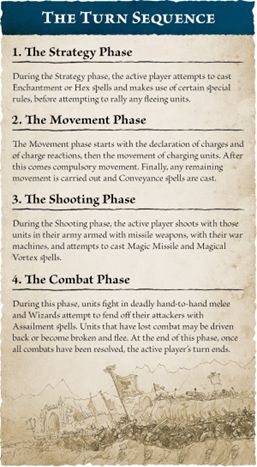
The standout here is that we have a new Strategy Phase and this can really help setup your turn. Enchantment spells applied to friendly units or Hexes on the enemy can give you the edge from the word go, and this is also when you use other abilities on characters such as the Tomb Kings Liche Priests Arise! Ability or the Empire Generals Rallying Cry.
Movement
Warhammer: The Old World is a “rank and flank” game where units form up into formations rather than moving freely while staying in squad coherency. Because of this, the movement rules are considerably more intricate than in any other currently supported GW game.
Movement starts with declaring chargers, which is done by measuring the units maximum charge range (Movement Characteristic + 6” + Any other benefits if appropriate) and deciding if you think you’ll be able to make it in to a target within that. Once all the charging units have been declared then your opponent goes through each of their units preparing to receive a charge and decides what they’re going to do.
There are a few options available to most units such as Holding to receive the charge, stand and shooting to unleash a final volley of shots at your assailants, or deciding you’ve got to make that dinner reservation after the battle and just choosing to flee the charge instead. Each of these comes with their own risks but the rulebook explains how to play them out. There are also a bunch of specialist reactions which certain units can perform but they’ll be listed under each units Special Rules if they’re allowed to. These aren’t massively widespread but a lot of elite Calvary can perform Counter Charge, while a few of the more nimble units or races have access to Fire and Flee allowing them to still launch a hail of arrows while attempting to get out of harms way.
Once this is all resolved, you start rolling dice to see who gets in (Movement Characteristic + Best of 2D6″ + Bonuses) and move those units in. The way this movement works has been amended slightly from old Warhammer Fantasy, but in effect it’s summed up as using as much of your movement as possible to bring as many of your models into base contact as you can.
Compulsory Moves are next and they’re followed by moving everything else. Movement rules are really important to a clean game, and will without a doubt be the section which takes you the longest to get your head around, especially if you haven’t played and Warhammer Fantasy before. Once you’ve got a few games under you’re belt it’ll really start to click though, especially if you’re a returning Fantasy player. What’s important is just making sure that you know what you’re trying to do, and working with your opponent to achieve it.
We’ll be putting out a few more different articles about the movement phase as it’s such a big part of the game.

Shooting
Unlike AoS or 40k, Warhammer: The Old World doesn’t use a simple Ballistic Skill (BS) stat with a target number to determine your skill with ranged weapons. Instead, you have a BS stat which you want to be as high as possible, and use this along with a host of modifiers to work out what you need to roll to hit your target.
Despite that, shooting is relatively simple. Work out who can shoot, pick targets, work out what you need to hit, roll to hit and wound, make saves and suffer casualties. Modifiers to your shooting include (but aren’t limited to) moving and shooting, firing at long range, standing and shooting, targets behind cover or additional effects from weapons or magic.
Wounding is done by comparing the weapons Strength and the targets Toughness, consulting a grid system and seeing what you’re required to roll. When the numbers are the same you’ll need to roll 4’s to wound where as if you’re hit with something slightly stronger then it might only be 3’s, hit with something really hard and it’s 2’s. Working the other way you can need 5’s, 6’s or find yourself in some very extreme cases unable to even wound your opponent, but I don’t think that last ones going to be popping up in anything but the most extreme circumstances.
Even after you successfully wound, a target might be able to just shrug it off depending on how much armour or special abilities they have. Armour saves are hard-capped at 2+ and those are pretty rare, with most Heavy Calvary finding themselves with a 3+ save unless they have access to Full Plate Armour (of various types), so you won’t see these in every army. A lot of basic troops might only save on a 5+ meaning a lot of damage does go through, while some troops may not get a save at all. Regeneration and Ward Saves both make a return allowing troops or characters special saves and a final chance to shake off damage before succumbing to their wounds. Models are then removed once they’ve lost their final wound, with most basic troops having a single wound and even the most powerful fighting Lords might only find themselves with 3 or 4 while on foot, so things do die when you hit them!
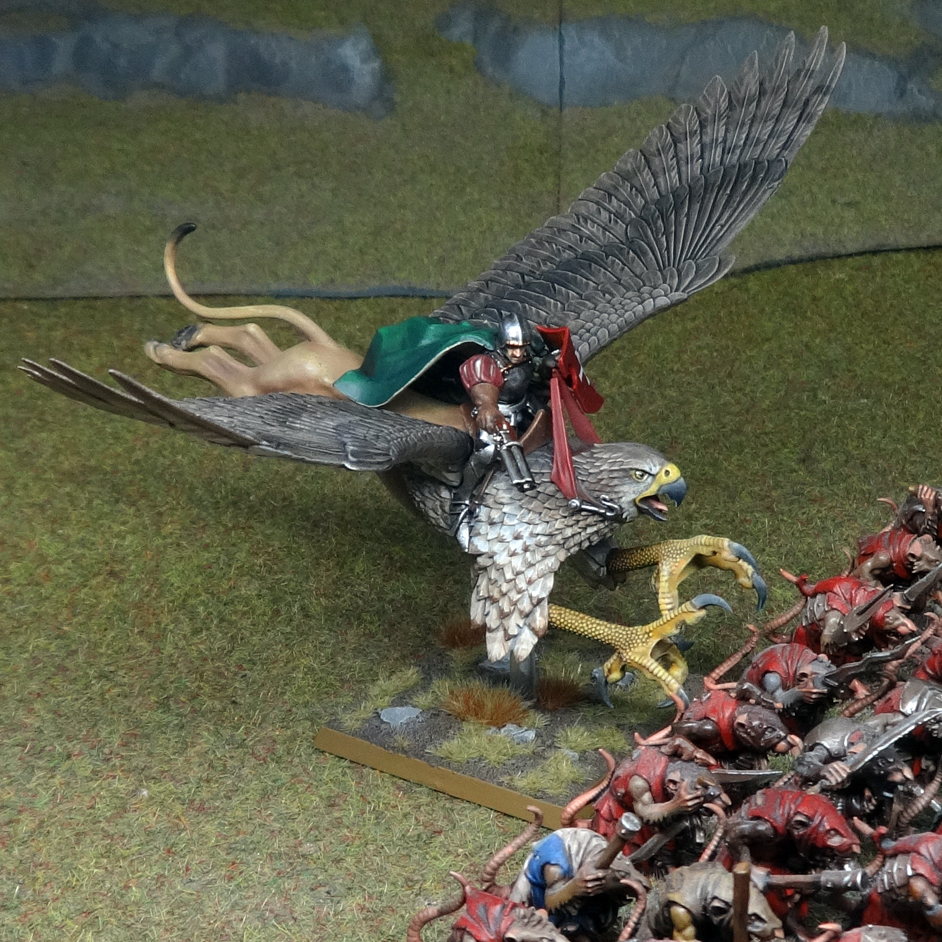
Combat
Combat works similarly to shooting; familiar hit, wound, save and remove steps, this time with a Weapon Skill vs Weapon Skill chart being used to determine how easy it is for your troops to hit your opponents in combat. There are some differences though which we’ll explore here.
Anyone in the front rank of a unit can fight in combat, which is a change from Warhammer Fantasy where only those in base contact with the enemy could fight. Now, models that are in the front rank but not in base contact still get to make a single attack. Since many models only have a single attack anyway, it’s only really cavalry and elite stuff that’s held back by this. This change represents troops surrounding their opponents and getting off a quick swing in melee before falling back ready to receive an enemies counter charge.
The other important thing to mention is that if you die in combat before swinging your weapon, no one is going to move up from the rear rank and take your place. This means that killing your opponent before they strike is very important and one way to swing combats in your favour. But how do you decide who strikes first? Well that’s where your Initiative characteristic comes in. You resolve fights in Initiative order, using your profile and any bonuses which are applied. For each full inch of charge movement prior to making contact with the enemy you gain +1 Initiative up to a maximum of +3 in your opponents front arc or +4 in the flank or rear. This means that canny generals can effectively double the Initiative of their units and strike much higher up the order when making the correct charge.
However sometimes you just can’t build up enough momentum. For example, Trolls are Initiative 1 and even charging High Elf Swordmasters from 5″ away would only make them Initiative 4. Swordmasters with their natural Initiative of 6 and Elven Reflexes taking them up to Initiative 7 in the first round of combat means they’ll still have chance to attempt to remove a troll or two from combat before they get clubbed.
Once you’ve fought the combat and removed casualties you get to the really fun part, combat resolution. For anyone who’s played Warhammer Fantasy in the past this was always the part of the game where single dice rolls could swing an entire battle. While that can still happen here we now have a sliding scale where troops will either Give Ground and move back 2″, Fall Back in Good Order where they’ll move back the highest of 2D6 or just Break under the pressure of the assault and run outright. We can use the example provided by the Warhammer Community team to show this below.
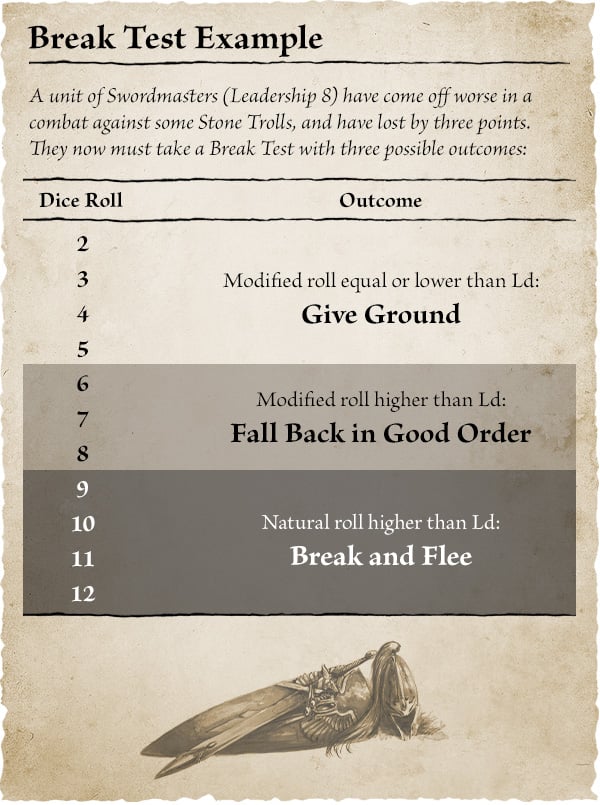
What’s key though is that the winner of the combat can react in different ways depending on the result rolled. For example if a Calvary unit makes an opponent Fall Back in Good Order (a strong possibility) then they can choose to follow on and in effect charge again keeping all their charging bonuses from their weapons and bonuses to Initiative, meaning they can force their way through even the most stubborn enemy formations and lines over a few rounds of combat. Another point to understand is that if the winning side sufficiently outnumber their opponents then they can turn a Fall Back in Good Order result into a break result, meaning that you won’t have to remove every last dwarf from the field, just enough to ensure your Unit Strength is twice that of the losing side.
I really like this version of combat resolution. It means that once forces clash and battle lines are formed they can shift a little. They can move depending on which side is in the ascendency and true hammer/anvil tactics are now something which are available to all the armies in the game, rather than just those who have really tough or really cheap blocks of infantry. I love the idea of having a solid unit of dwarfs being really hard to shift but knowing they’re only going to hold out for so long before they need assistance, just feels really dramatic and very Warhammer.
There are also a bunch of examples in this section of the book covering multiple combats, oddball stuff and explanations of how certain rules work which should make things a lot easier on the table top when you get to those complicated situations which can arise from a regimental game.
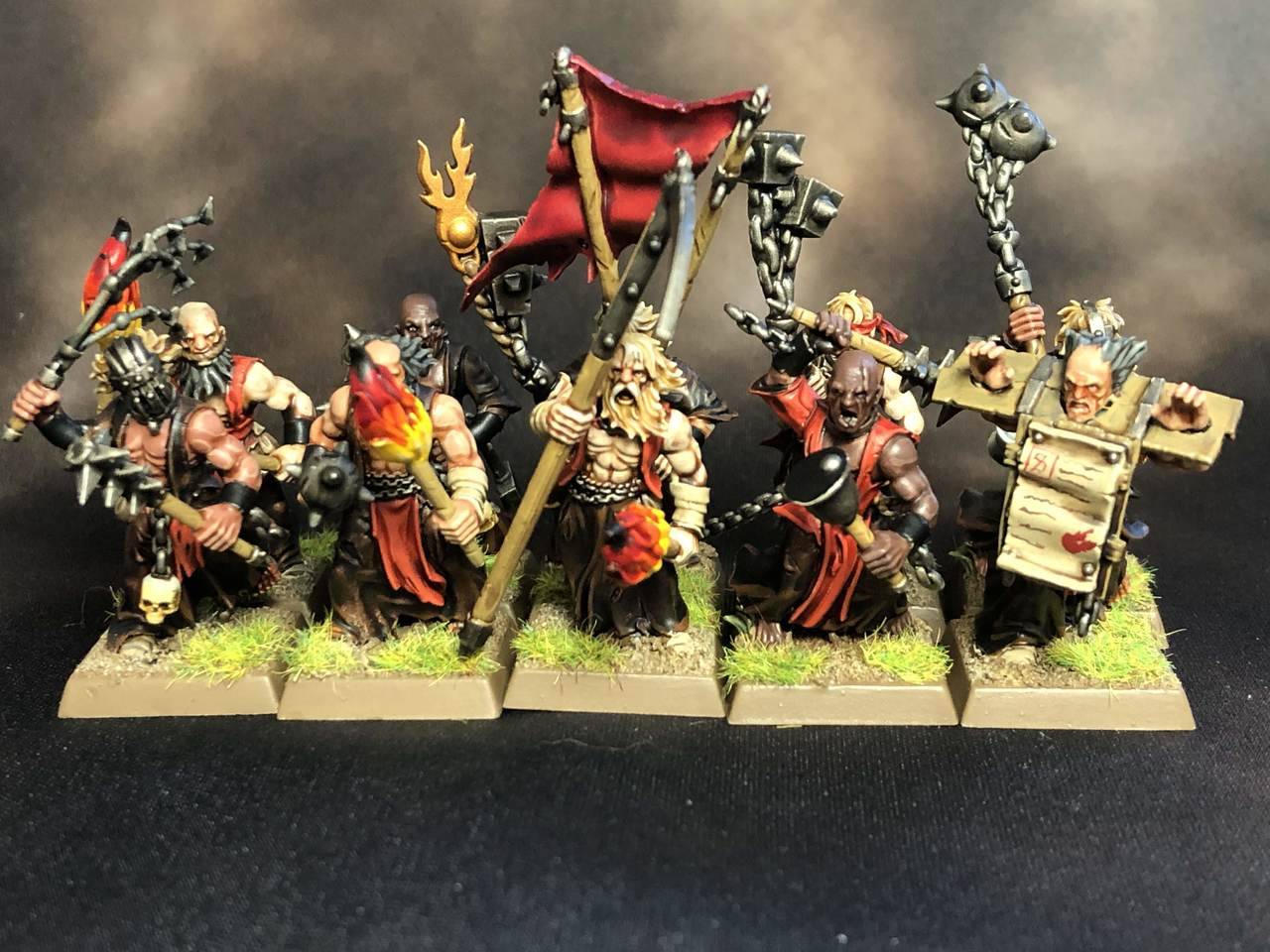
Psychology
The last of the major rules sections are the Psychology rules, and they won’t be alien to anyone who’s played Warhammer Fantasy in the past. They’re also pretty streamlined here, so shouldn’t be too tough for new players to pick up, working based on a mixture of maths and proximity.
Panic tests are a simple Leadership test and can be caused by a host of circumstances such as the unit losing models to enemy shooting or magic, watching a friendly unit get destroyed, seeing a friendly unit break in combat or having a friendly unit through right through your own formation but similar to combat we have 2 types of fleeing. If you still have more than 50% of your unit left you Fall Back in Good Order while only if you have 50% or less of your starting number you Flee. A small amendment but a great one, who knew having friends around you would help you stand up to things right?
Special Rules
For anyone who’s played different games from any manufacturer over the years there’s always a debate on this. What’s better? To have each rule written out for each unit or to have a big list of rules, then anyone with that rule must follow the exact same rule? Honestly I’m not sure but for The Old World the second feels right. With such a wide variety of units and armies having thirty different ways to say “ignore this damage on a 6+” or similar would have taken up a lot of time and space and after a few games if functionally the same as saying “Regeneration (6+)” on every unit with that same rule.
Special Rules are broken up into three categories. In the main rulebook, we have Universal Special rules like Regeneration above, which can appear in any army, and apply the same wherever they do. Army Special rules apply to certain armies, examples of which include the Bretonnian Blessing of the Lady rule or the High Elf Elven Reflexes rule, and these appear alongside the relevant part of the Forces or Fantasy or Ravening Hordes books. Finally you have Unique Special Rules, which applies to one specific unit only, such as the Flagellants Fanatical Zeal special rule. These rules are found in the relevant unit entry. It’s a pretty simple system, and making a lot of rules Universal really helps your opponent get a headstart on understanding what your units can do. Once you’ve played against one Close Order unit you’ll know what to expect, even if the next one you encounter is from a completely different faction.
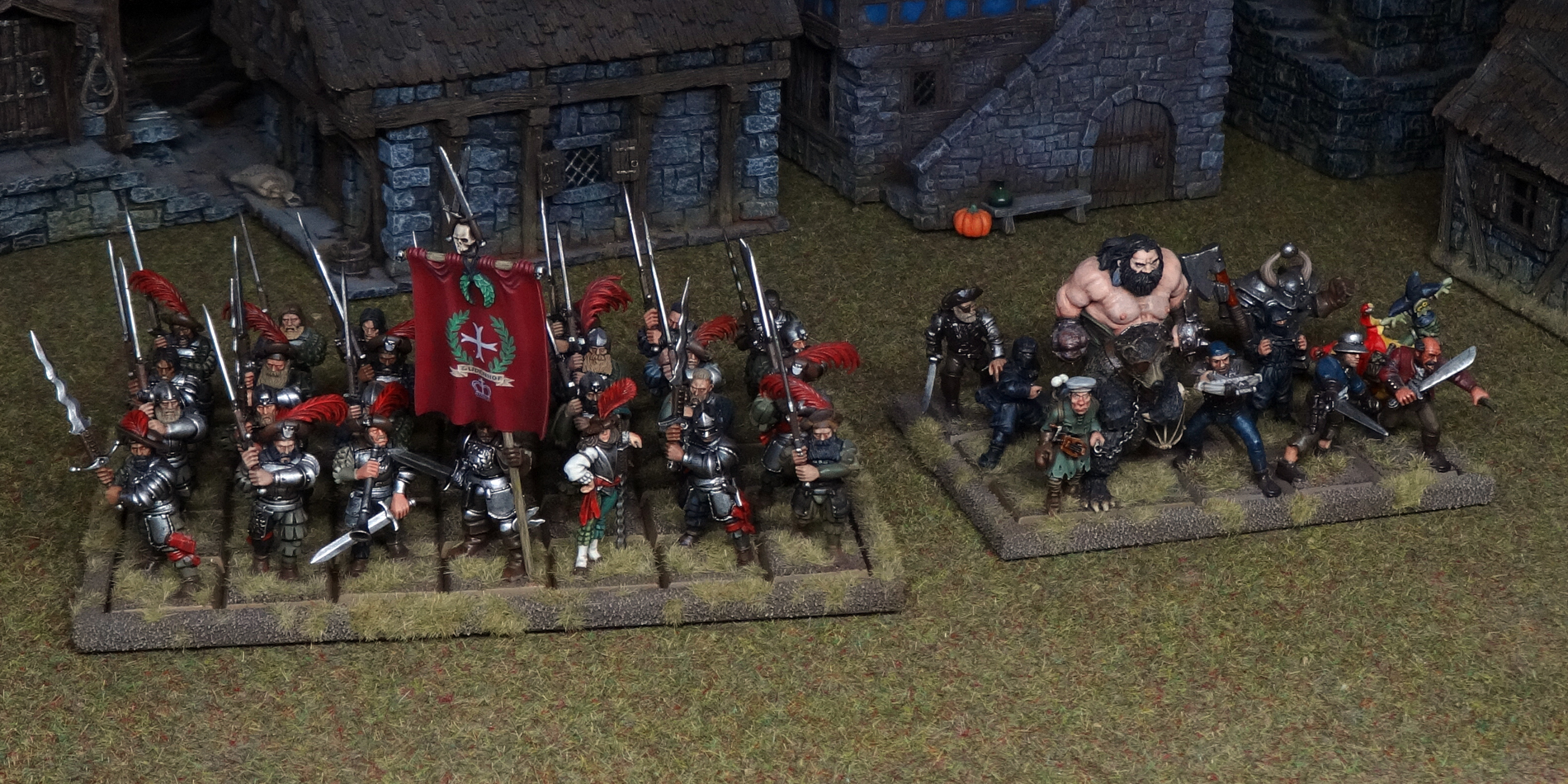
I’m not going to go through all the special rules, but some of my favourites include;
- Counter Charge which lets some more mobile units dash towards their opponents when charged letting them get the most from their weapons, this is usually on a lot of elite level Calvary.
- Detachment which allows you to take some units in slightly smaller sizes to support main units. I’m a big fan of High Elf Archers being taken this way to support the main Spearmen blocks.
- Fire & Flee which allows some quick or fleet footed units to try and fire off one volley at charging units in exchange for some of their movement when fleeing.
- Horde which increases the amount of rank bonus available in combat for some of the cheaper more generic units in the game.
- Rallying Cry which gives some commanders an additional chance to rally a fleeing unit to keep key units on the table.
- Timmm-berrr! which is used when some of the larger creatures in the game lose their final wound and need to find somewhere to land, hopefully not on your own troops!
Weapons
In Warhammer Fantasy, weapons used to have a few special rules and associated bonuses, and you’d also use the strength of the weapon and/or user to determine how they modified armour saves. The Old World introduces a different system that’s closer to how 40K and AoS resolve this, where each weapon has a profile encompassing the above.
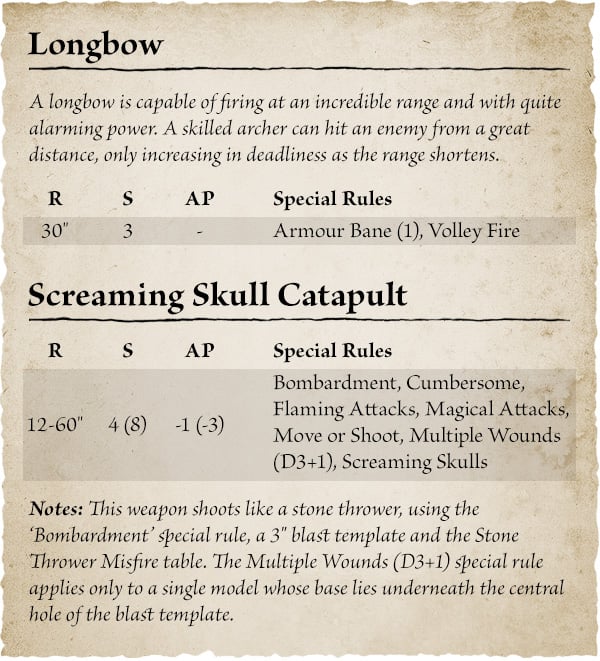
As you can see from the above each weapon has a range (which can be combat), a Strength value (either flat or a modifier applied to the bearer’s characteristic), an Armour Piercing value and Special Rules. What this has done is allow the design studio to make very minor adjustments to weapons which are very similar to each other and gives them a little more room to apply incremental changes.
For example lets look at the Great Weapon. This is a Range Combat weapon, with a Strength of S+2 modifier and an AP of -2 with the Armour Bane (1), Requires Two Hands and Strike Last rule. It’s pretty straight forward but what happens when you get to other similar weapons? In Warhammer Fantasy Swordmasters of Hoeth and White Lions both had Great Weapons, in Warhammer The Old World neither do. The Sword of Hoeth is a combat weapon with a strength of S+2 and an AP of -2 but has the Magic Attacks and Requires Two Hands special rules meaning it doesn’t strike last while the Chracian Great Blades of the While Lions trade the Great Weapons Armour Bane (1) rule for a flat AP Value of -3 showing how it’s a more finely tuned weapon used by experts in their craft. These are just small examples of how they can make similar weapons work in different ways, and with 26 different types in the main rulebook and a host of army-specific ones, we’ve got a treat ahead of us working out what works best in what situation and what costs are associated with choosing the weapons we do.
Armour
This protects your troops in battle, the more you’re wearing then the better your save. There are three types of common armour, light, heavy and full plate and there are a bunch of additional armour types for certain armies. These provide different bonuses such as Gromril armour allowing re-rolls of 1 on your saving throw, or Chaos Armour providing an inbuilt Ward Save. You can also increase these saves by being on a barded mount (sure as a Warhorse or Elven Steed), having a shield or by having special rules such as Armoured Hide (X) or magic items.
The final key point to this is that all armour saves are now capped at 2+ meaning you’ll no longer be able to have an indestructible character standing in front of an enemy unit and weapons with a -1AP modifier actually means something in those cases.
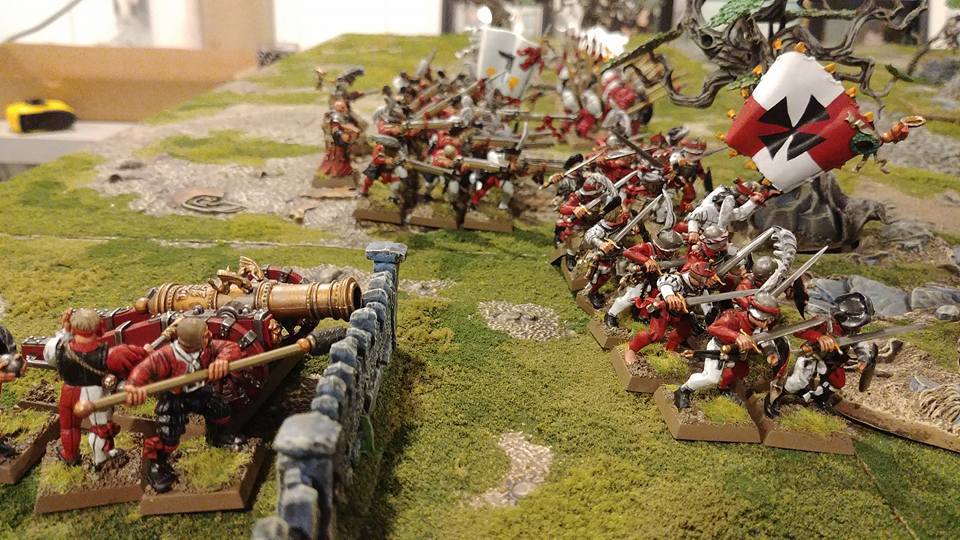
War Machines
It wouldn’t be Warhammer without these weapons of destruction. Overall while being slightly toned down from the Warhammer Fantasy days, these are still the biggest damage dealing single weapons available to most armies, albeit at a cost of risking misfires. The Bolt Throwers are you most reliable but least damaging weapons of destruction, while mechanical Stone Throwers can deal loads of damage to mass infantry blocks with some risk of mishap. Finally you have the iconic black powder versions in Cannons, Great Cannons, Organ Guns and Fire Throwers, which do massive damage, but risk massive consquences when things go awry.
Magic Lore/Items
Circling back around to Magic before we part ways ,we have the eight Lores of Magic which are available to different magic casters. As mentioned each one includes a host of different spells and effects based around the theme of the lore. I’m just going to pick out my favourite spells from a few lores.
- Battle Magic – Arcane Urgency, a conveyance spell cast on a 10+ allowing a unit which has already moved to move again. Great for getting troops where they need to be
- Daemonology – Gathering Darkness, Hex spell cast on a 9+ which until the start of the casting players next Start of Turn Sub Phase debuffs a target with -2 Initiative, -2 to Leadership and prevents them from using their General’s Inspiring Presence special rule. Great for getting through a tough roadblock in the enemies force.
- Dark Magic – Battle Lust, cast on a 9+ and already previewed by the Warhammer Community team this lest you give a unit Frenzy and Hatred (all enemies) special rules allowing your hard hitting troops to really crank it up in combat.
- Elementalism – Plague of Rust which when cast on a 9+ Hex’s an enemy unit within 21″ to have a -2 modifier to their armour save. Just what you need when you’re going into combat against the enemy general and retinue.
- High Magic – Walk Between Worlds which when cast on a 10+ grants the caster and their unit the Ethereal and Reserve Move Special rule. Great for when you need bailing out of a bad situation against an enemy either without magic weapons or when you need to get out of dodge!
- Illusion – Column of Crystal which is a Magical Vortex cast on a 10+. You place the large 5″ blast template with it’s hole within 9″ of the caster and while in play the template doesn’t move but is treated as impassable terrain which Line of Sight can’t be drawn over. While short range can this can really mess up an opponents plans or if your wizard is forward really limit an opponents shooting plans for a round or two.
- Necromancy – Unquiet Spirits which is cast on an 8+, this Magic Missile hits an enemy within 15″ for 3D6 Strength 2 hits, which allow no armour save. Great for taking apart heavily armoured human or elven mounted units.
- Waaagh! Magic – I couldn’t not really pick Foot of Gork here could I? on a 8+ you place the 5″ black within 15″ of the caster and the Vortex is treated like difficult terrain. In addition it moves 2D6″ in a random direction every players Start of Turn Sub Phase and any unit hit suffers D3+3 Strength 5 -1AP hits. Great destruction on the table, if a little uncontrolled, just like the creatures Gork looks over.
Magic items come in all the varieties you’d expect and can usually only be taken once per army. Some are extremely common and can be taken multiple times, and a lot of units can now take 25-50pts worth of magic items on their champions, so hopefully we’ll see a few more of the cheaper ones in game. Similar to above I’m just going to pick my favourites from each type (Weapons, Armour, Talismans, Standards, Enchanted and Arcane) of item available.
- Weapon – Giant Blade which for 30pts gives you Strength+1, Armour Bane (2), Magical Attacks and Multiple Wounds (2). Overall a great package at the price point.
- Armour – Shield of the Warrior Tree another 30pt items, this one gives you a 5+ Ward in the shooting phase, great for strapping to that Elven Lord on a Dragon or Bretonnian Duke on a Hippogriff. Especially handy if you’re using your Talisman slot on another item.
- Talisman – Dawnstone, remember me saying how saves were capped at 2+? Well why wouldn’t you want to reroll any saves of a natural 1? Great! Now you can. A snip for a heavily armoured lord at 35pts.
- Magic Standard – Rampaging Banner lets you reroll your charge roll. Gets your unit exactly where it wants to be quicker than normal, not bad for a swift 30pts.
- Enchanted Item – Ruby Ring of Ruin gives you the Fireball spell cast on a Power Level of 2 (plus 2D6), a great weapon to add a little extra firepower at ranged to almost any army for 30pts.
- Arcane Item – The Wand of Jet is my favourite here giving your wizard +1 to any of their casting/dispelling rolls for only 45pts. It does come with a downside that if you roll any double the wand is destroyed and can’t be used again but until it does you’ll feel extremely powerful no matter what wizard you are.
Playing & Winning a Game
We’ve got six different deployments and scenarios contained in the rulebook and each one has a very similar Victory Points (points gained for killing enemy troops) scoring system, plus ome additional scoring depending on the scenario and bonus points for killing the enemy General or removing enemy Standard Bearers from the table.
The Scenarios are based around six historical battles but will look familiar to players of Warhammer Fantasy. We’ve got Open Battle, Break Point, Flank Attack, Meeting Engagement, Mountain Pass and finally Command & Control.
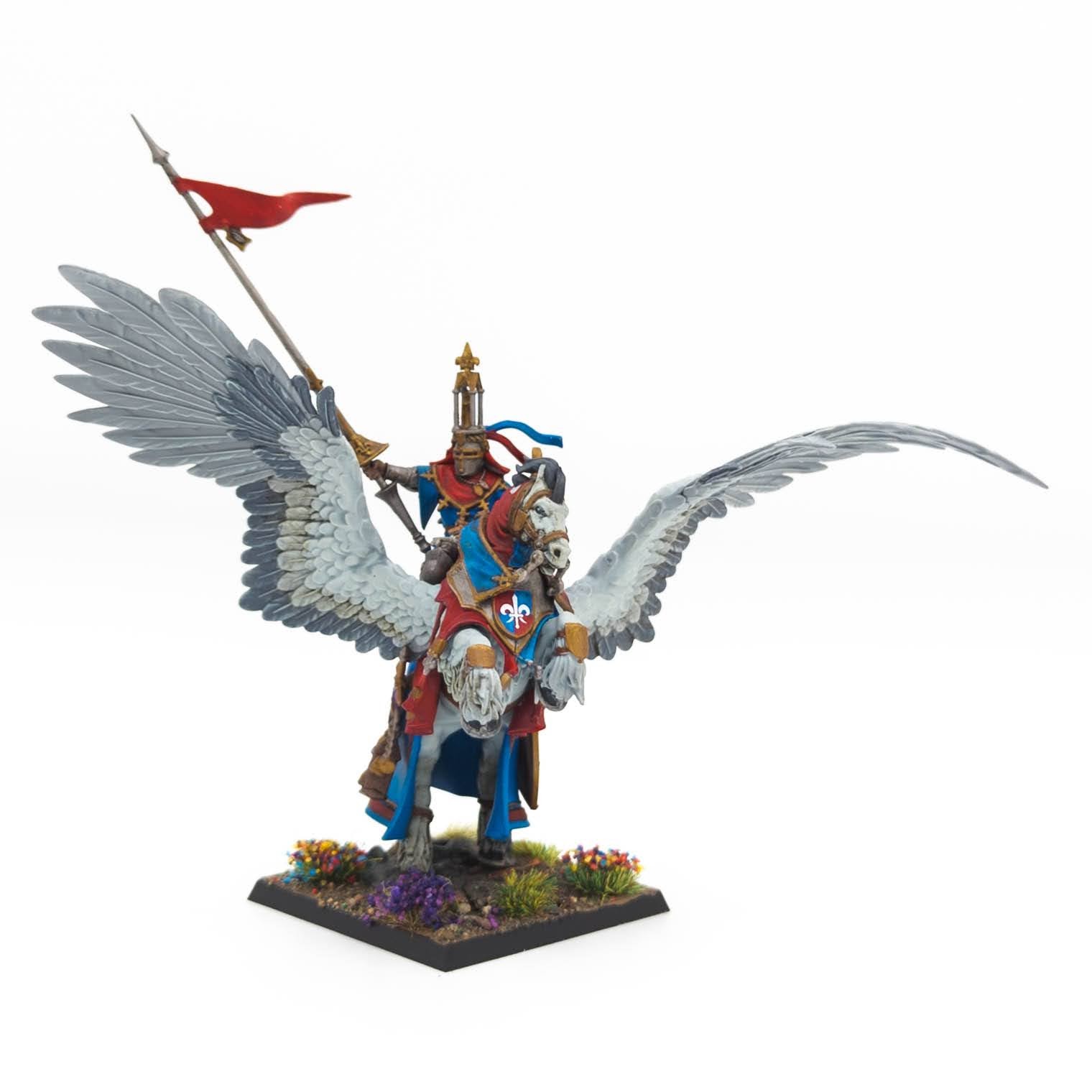
Other Rules
There are a few more sections that we didn’t cover because they focus on intricacies, but rest assured that rules for how to (for example) embed Characters in units all appear in appropriate places.
Summary
There we have it, a quick rundown of the main talking points of Warhammer The Old World from my view. I think the final thing I want to mention is at the end of rules you have Quick Reference section of the rules and a big index which allows you find rules much quicker when needed.
The games is launching in a really good place and I really like the vast majority of the design decisions they’ve taken producing it. There was a quote in an early Warhammer-Community article which said they’d played every edition of Warhammer Fantasy from third though to eighth and taken the best bits to make The Old World and I really do feel that’s the best way to look at it. Taking in a few elements from Warhammer Ancient Battles and the almost Horus Hersey inspired style for using magic and you’ve got elements of a system which not only works, but flourishes in what it’s set out to accomplish.
Since getting my hands on the rules for this review I’ve played more than a few games with a wide variety of armies and they’re all kept their feel while embracing some new ideas and I can’t wait for the 20th to hit and to be able to play more games with new opponents. I’m looking forward to what the team behind this launch can come up with moving forward and hopefully some of the things alluded to in the background or lore sections of the rulebook come to pass.
So what are you waiting for? Get a list written up (either 1250 to match those in the Army Boxes) or 2000 for what the Community Articles seem to imply as a full game and lets get back to The Old World.
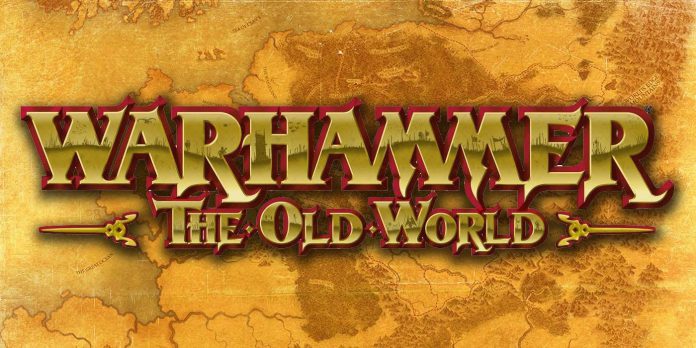


You must be logged in to post a comment.